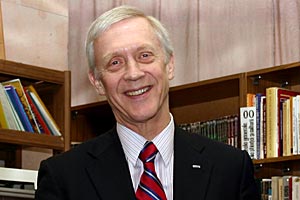
OSCE PARLIAMENTARY RESOLUTION SETS STAGE FOR RECOGNITION OF TRANSNISTRIA
Publication: Eurasia Daily Monitor Volume: 2 Issue: 133
By:

On July 8, Moldova’s Ministry of Foreign Affairs issued a protest against the content of the Moldova resolution, adopted at the OSCE Parliamentary Assembly’s (OSCE PA) annual session on July 5 in Washington, and against the procedural maneuvers that were used to push the resolution through. The resolution appears designed to set the stage for international recognition of Transnistria’s secessionist authorities, following elections to be “conducted by the OSCE” there.
Finnish left-leaning parliamentarian Kimmo Kiljunen, head of the OSCE’s Parliamentary Team on Moldova and long known as a Tiraspol sympathizer, prepared that resolution. The OSCE’s Moldova Mission chief, American diplomat William Hill, assisted in the preparation and flew to Washington to lobby for the document’s passage. In the event, the OSCE PA approved it with less than half of the deputies present voting in favor, a smaller number against, and a sizeable number of deputies not voting. Officially, therefore, the document has the status of an OSCE PA resolution and will henceforth be used against Moldova.
The small Moldovan delegation was badly outplayed in the procedural maneuvering that led to the adoption of the document, despite the latter’s flaws. Almost all of the 20 Moldovan amendments failed to pass in the Political and Security Committee.
Some of the rejected amendments would have: a) urged Russia to withdraw its troops from Moldova’s territory; b) defined the conflict as an international one between Russia and Moldova, rather than an intra-Moldovan conflict; c) changed the document’s phrases that implied co-equal status for Moldova’s and Transnistria’s authorities; d) asked for internationalization of the negotiating format, so as to include the United States, the European Union, and Romania; e) cited the Transnistrian authorities’ involvement in international criminality; f) required democratization efforts and civil-society building in Transnistria as a prerequisite to holding any internationally-supervised elections there; and g) envisaged that only those holding Moldova’s citizenship could vote and run for office in any internationally-supervised elections in Transnistria (a precaution against Russia’s military and civilian functionaries, now ruling Transnistria on Russia’s behalf, getting themselves re-elected and recognized internationally).
All of these amendments were turned down in committee after Kiljunen spoke up against them. The proceedings were too fast, the issues too unfamiliar to this forum, and Kiljunen’s and Hill’s advance work too effective, for the poorly prepared Moldovan delegation to be able to change the outcome.
In the event, the adopted resolution proposes “to mandate the OSCE to conduct elections in Transnistria.” On this point, the document cites approvingly the Ukrainian conflict-settlement plan for proposing something similar. Such quick-fix elections could, however, only result in a Soviet-style plebiscitary retention of the incumbent authorities.
The resolution asks “Transnistria’s authorities to take much-needed steps to encourage the further development of political parties, civil society organizations, media outlets, and other such democratic institutions in Transnistria.” The formulation “further development” implies that democracy in Transnistria has already advanced somewhat — a view that Kiljunen and Hill would seem to share. The document’s expectations on this point might seem naïve in that it leaves democratization fully at the discretion of Transnistria’s dictatorial authorities, without stipulating any international involvement. In fact, it only reflects the OSCE’s lack of access in Transnistria and lack of will to carry out its mandate there, along with its desire to retain control of the “settlement process” at the expense of the weaker side — Moldova.
Throughout the resolution, Moldova’s governing authorities (freely elected and European-oriented) are placed on the same footing with Transnistria’s authorities (externally imposed, exercising Soviet-style police rule, and pursuing a Greater-Russia orientation). The resolution calls for resumption of negotiations in the old format (from which Moldova withdrew, and which Moscow, Tiraspol, and the OSCE want reactivated). It also urges “the Parliament of Moldova and the Supreme Soviet of Transnistria” to open a negotiating track of their own. (This has long been a Hill-Kiljunen tactic, hoping to use certain individuals in the Moldovan parliament to undercut the government’s position.)
Ultimately, the resolution’s main goal is neither to side with Tiraspol, nor to advance Russian interests (the OSCE did this in 2002-2004 at the diplomatic level in Vienna and Chisinau, but not in the OSCE PA, and seems to be taking a pause for reflection this year). This resolution appears mainly designed by its two authors to empower the OSCE in Moldova as a lifesaver for an organization in agony. By legitimizing Transnistria, the OSCE could earn a reprieve from Russia’s attempts to emasculate the OSCE’s election-monitoring functions in the “post-Soviet space.” By taking over (again, with indispensable Russian consent) a peacekeeping mandate in Moldova — following the recognition of Transnistria — as the resolution proposes, the OSCE could survive as a security actor. Sacrificing Moldova may seem a small price to pay for all this.
Almost certainly, few of the OSCE PA’s members had sufficient time or detailed knowledge to realize the implications of this resolution during the hectic proceedings of this forum.




